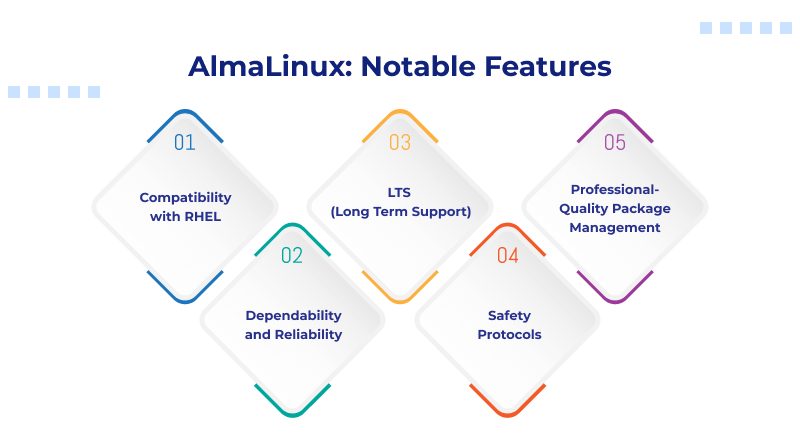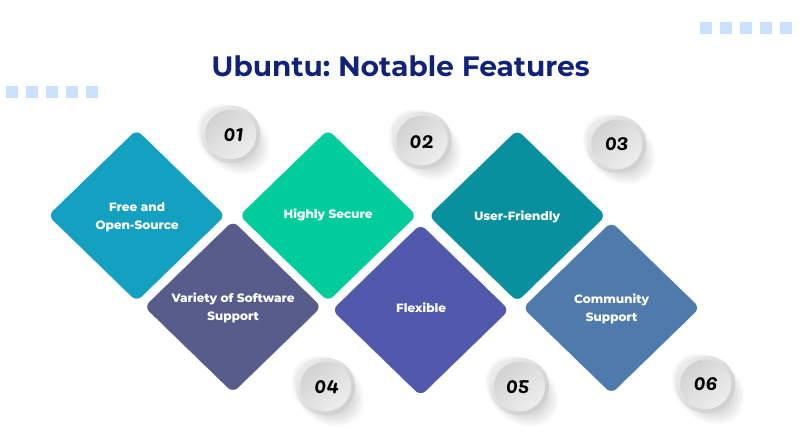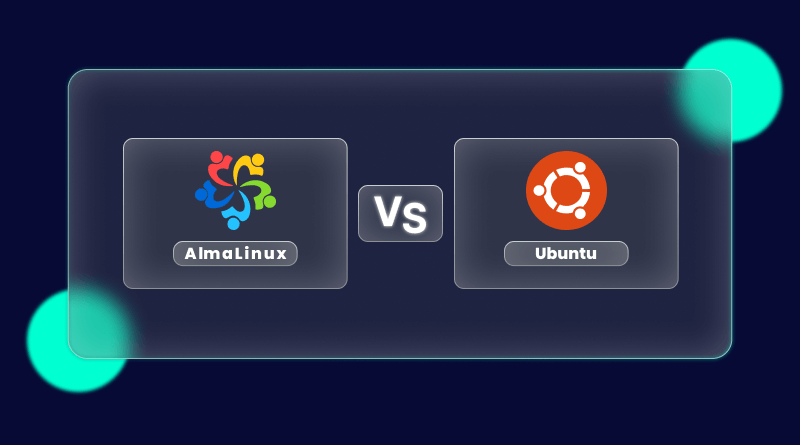Are you the one who’s facing the dilemma of choosing between the best Linux distros—AlmaLinux vs Ubuntu, just like many other users? Where AlmaLinux is a community-driven fork of RHEL, well-known for its solid performance and enterprise-class functionalities, which makes it a leading option for server platforms.
On the contrary, Ubuntu is a widely recognized Linux distribution, extensively utilized for desktop as well as server installations because of its ease of use and strong community-driven support. This comparison between AlmaLinux vs. Ubuntu servers holds value for everyone because it can have a major impact on the performance, safety, and operationality of your system, irrespective of whether you require it for handling enterprise-grade servers or configuring a personal computer.
The commercial-grade AlmaLinux VPS servers provide excellent performance, specifically crafted for demanding tasks. In this detailed comparison, we’ll take a look at the overview of both of these operating systems, their notable features, pros and cons, and best use cases to guide you in finding the best Linux distro for every user’s distinct requirements.
Before getting into details, let’s try to understand the concept of a server platform.
Table Of Content
Server Platform Explained
A server platform is like a backbone for website hosting and supporting other crucial workloads. The server platforms like Windows and Linux offer various essential resources, safety features, and a framework for managing customer requests, handling data, and deploying services.
Global rankings of Linux-powered websites:
Continuing on this track, let’s understand what an operating system is.
Operating System Basics Explained
An operating system is a crucial factor of software that facilitates communication between the computer hardware and the software applications that an individual operates on. It also helps in managing various computer resources by providing an easy-to-use user interface for users to operate the computer and run various programs.
Brief Overview Of Almalinux
– What is AlmaLinux?
AlmaLinux is one of the most popular, free, and open-source Linux distributions developed as a viable option for CentOS in December 2020.
- Background And Development: AlmaLinux is built and managed by the community-powered AlmaLinux OS Foundation, which is focused on offering a trustworthy and well-supported operating system with long-lasting support perfect for enterprise-level platforms. It is developed with the help of the upstream source code of Red Hat Enterprise Linux, i.e., RHEL, which assures compatibility and an effortless transition for those who have previously used CentOS for their server setups.
- Target Audience And Use Cases: By emphasizing a powerful and community-focused approach, AlmaLinux acts as a strong alternative for businesses looking for a safe and secure Linux distro for their server configurations.
AlmaLinux: Notable Features
AlmaLinux was developed to offer a safe and reliable server platform, which makes it perfect for enterprise-class applications. It provides binary compatibility with Red Hat Enterprise Linux, which assures a flawless transition for users who are migrating from RHEL.
Moreover, AlmaLinux’s regular safety updates alongside extensive community support foster a stable infrastructure for servers as well as cloud setups.

– Compatibility with RHEL
AlmaLinux is binary compatible with Red Hat Enterprise Linux, which means various software and processes that are created or tested on the RHEL platform can effortlessly work on AlmaLinux.
– Dependability and Reliability
Similar to RHEL, AlmaLinux focuses on delivering reliability and stability, which makes it perfect for production settings where a powerful and reliable OS is necessary.
– LTS (Long Term Support)
AlmaLinux offers long-term support, in short, LTS, for its versions, alongside regular security updates as well as maintenance for a long period of time. This is specifically beneficial for business users who need a dependable and reliable server platform for a prolonged duration.
– Safety Protocols
AlmaLinux draws safety features from Red Hat Enterprise Linux, along with SELinux, i.e., Security-Enhanced Linux, for managing access control, firewall management options, and other additional safety measurements.
– Professional-Quality Package Management
Using the RPM-based package management system, AlmaLinux delivers an easy-to-use and robust set of tools for installation, updations, and software package management.
Pros of Using AlmaLinux
AlmaLinux provides exceptional performance and RHEL compatibility, positioning it as a preferred choice for corporate settings. Its active community support guarantees timely updates and safety enhancements for mission-critical applications.
Potential Drawbacks of Using AlmaLinux
Despite that, AlmaLinux might need more comprehensive community-specific resources and support for third-party software, which is common in the majority of well-known Linux distributions and can restrict the choices for individuals and businesses who want to run a broad array of applications. Moreover, newbies might find it difficult because of the unavailability of the graphical user interface in certain settings.
Brief Overview of Ubuntu
– What is Ubuntu?
Ubuntu is Linux’s other most commonly used distro, released in 2004. The primary aim of Ubuntu is to provide an intuitive and easy-to-use Linux experience for newbies.
- Background and Development: Same as Linux, Ubuntu is also an open-source as well as easily customizable operating system. Its first version was developed on Debian and comes with many releases, like Ubuntu Desktop, Ubuntu Server, and Ubuntu Core for Internet of Things (IoT) devices.
- Target Audience and Use Cases: This Linux distribution has a wide-ranging audience base, such as developers, individuals, and businesses.
Ubuntu: Notable Features
Ubuntu is popular for its beginner-friendly user interface and active community support, which makes it a perfect choice for newcomers as well as experienced webmasters. It provides massive software repositories, which enable users to deploy and manage a variety of applications effortlessly.
Moreover, its solid emphasis on safety measures and timely updates provides a dependable and safe platform for desktop as well as server installations alike.

– Free and Open-Source
Ubuntu is freely available for download and use, as there are no licensing fees or hidden charges involved.
– Highly Secure
Ubuntu is regularly updated with improvements and bug fixes, which is among the safest Linux operating systems available.
– User-Friendly
Ubuntu is user-friendly and specifically developed for novices. It also provides a visually striking desktop platform and a variety of applications for increased efficiency, media editing, and entertainment needs.
– Variety of Software Support
Ubuntu provides a comprehensive operating system with pre-configured software and web applications together with Firefox, LibreOffice, and GIMP. It is possible to deploy different software from the Ubuntu Software Center or through third-party repositories.
– Flexible
Users can use this Linux distro on different devices like desktops, laptops, servers, and even on Raspberry Pi, providing flexibility and efficiency across multiple hardware platforms.
– Community Support
Ubuntu is so much better because of its extensive and sizable community of users and web developers. Whereas its long-term support versions, i.e., LTS, provide reliable and secure updates for as long as 5 years.
Pros of Using Ubuntu
Ubuntu provides extensive hardware compatibility and ease of use, which makes it perfect for desktop as well as server platforms. Ubuntu’s long-term support versions provide regular updates and security fixes, with a stable and reliable platform for commercial purposes.
Potential Drawbacks of Using Ubuntu
Besides Ubuntu’s strengths, it might need additional system resources, contrary to other lightweight Linux distributions, which can compromise performance on outdated hardware machines. Furthermore, its periodic updates and modifications might lead to unusual compatibility problems with particular applications.
AlmaLinux vs Ubuntu: Detailed Analysis
1. AlmaLinux vs Ubuntu: Performance Comparison
When comparing AlmaLinux vs Ubuntu for performance, it is necessary to take their unique strengths into account. Alma Linux is developed as a direct alternative to CentOS, outperforming the platforms that require stable and reliable environments, specifically in server installations.
Its improvements for enterprise-level applications most of the time result in effective resource usage and provide consistent performance during intensive workloads. This makes it a leading contender when evaluating the Alma Linux vs. Ubuntu server.
On the contrary, Ubuntu servers provide an all-around performance, supporting both servers as well as desktop users. It is backed by huge active community support, and its beginner-friendly user interface makes it an appropriate solution for newcomers.
Apart from that, Ubuntu’s timely updates and latest features provide strong performance in a variety of applications.
2. AlmaLinux vs Ubuntu: System Requirements
While weighing different options for the AlmaLinux vs Ubuntu server, it is important to consider their core system requirements for top-level performance. Both of them can effectively work on moderate hardware, but Ubuntu’s higher system requirements provide a more powerful desktop experience.
Therefore, always weigh your use case with available hardware specifications when deciding between Ubuntu and AlmaLinux.
AlmaLinux System Requirements
It usually requires:
- Processor: 1 GHz or faster
- RAM: Minimum 1 GB, but usually 2 GB is recommended for maximum performance.
- Disk Space: At least 10 GB of free space, generally 20 GB is recommended.
- At least 8 GB of USB flash drive, generally 2 GB or more, is recommended.
Ubuntu System Requirements
Ubuntu, generally well-known for its beginner-friendly user interface, usually has slightly different system requirements:
- Processor: 2 GHz dual-core processor
- RAM: Minimum 2 GB; usually 4 GB is recommended for a flawless user experience.
- Disk Space: Minimum 8.6 GB, 25 GB of free space for better performance of a hard disk drive space or USB stick, memory card, or external drive. But also check out LiveCD for an alternative method.
- VGA: Up to 1024×768 screen resolution
- For Installer Media: Either a CD/DVD drive or a USB port
- Internet Access: Optional
3. AlmaLinux vs Ubuntu: Community and Support
The AlmaLinux active community has all the essential resources that you require for assistance. A correctly orchestrated documentation, forums—a discussion group, clienteles, Mattermost Community Chat, IRC Real Time Chat, a Discord community, and a Reddit community forum of around 5k members—are several options you can rely on when you are looking for help with this Linux Distro.
Ubuntu, regarded as one of the leading Linux distros, has strong community assistance. It also has in-depth documentation. You can join TRC channels in order to inquire about specific topics and get help.
Ubuntu Discourse provides an alternate space for community discussions on current developments. You can always seek assistance from Ubuntu Forums and AskUbuntu for any technical help.
4. AlmaLinux vs Ubuntu: Software Update and Release Strategy
AlmaLinux rolls out new updates whenever there’s a new version of RHEL available. It can take nearly 1 business day to complete. On the other hand, whenever RHEL releases major updates, it can take anywhere from a few weeks to several months. You also receive 10 years of support similar to RHEL.
Ubuntu is accompanied by a standard release cycle and 2 different release models. The first is the LTS version, i.e., Long-Term Support, which is rolled out on a biennial basis and receives 5 years of support. When you choose Ubuntu Pro, then you get an extra 5 years of support. The other updates are interim releases that are rolled out every 6 months between two long-term support (LTS) versions. These non-LTS versions receive support for a total of 9 months.
5. AlmaLinux vs Ubuntu: Security
AlmaLinux offers regular security updates and software fixes. Additionally, they also offer several security software and tools, like OpenSCAP, Errata, and public OVAL streams. You also receive the SCAP Workbench GUI tool, like accessibility to the official CIS Benchmark for AlmaLinux. Another important package is SBOM, i.e., Software Bill of Materials integration with the AlmaLinux build system.
Ubuntu stands out as a secure option as it follows all the safety guidelines from the beginning, has faster security fixes, and has leading-edge and secure software applications. Ubuntu’s Canonical Livepatch service addresses all the critical kernel problems without having to interrupt your workflow by rebooting your system.
6. AlmaLinux vs Ubuntu: Standard Desktop Interface
AlmaLinux 9 makes use of the GNOME shell by default. Nevertheless, you can seamlessly change to the Classic Mode. At the time of logging in, you can select the Classic Mode through the settings option located at the bottom right corner of the screen. Its desktop GUI, i.e., graphical user interface, is well organized and modern.
GNOME is the primary desktop interface that comes with Ubuntu. As GNOME is popular for its user-friendliness and for transforming the contemporary look of desktops into a fresh and trendy look.
Best Use Cases for AlmaLinux
AlmaLinux is one of the most flexible Linux distributions that acts as a perfect choice for different use cases. Its excellent alignment with Red Hat Enterprise Linux (RHEL) makes it ideal for business platforms that need reliability, stability, and safety.
Several web hosting businesses make use of AlmaLinux for their web servers, offering powerful web hosting options for various websites and applications. AlmaLinux is also proficient in containerization, offering powerful infrastructure for handling Kubernetes and Docker, which is necessary for microservice architectures.
For developer environments, it provides a familiar framework for developing and testing different applications. Furthermore, it is best suitable for cloud solutions, specifically for virtual platforms, because of its lightweight nature.
Best Use Cases for Ubuntu
Ubuntu’s versatility makes it one of the best Linux operating system options for a variety of applications, like web development, server deployments, IoT applications, machine learning, data science, and desktop usage.
Because of its exclusive support for commonly used programming languages and frameworks, you can use it for web hosting services.
That brings us to the end of this comparison between Ubuntu vs AlmaLinux. Both of these Linux distributions provide several distinct features that effectively serve their users. Ubuntu is more compatible with newcomers who are looking for operating systems to kick-start their journey. It is also useful for frequent use on desktops as well as laptops.
On the contrary, AlmaLinux is excellent for enterprise platforms. Because of its binary compatibility with RHEL (Red Hat Enterprise Linux), it has become popular among businesses and enterprises.
FAQs
Alma Linux vs Ubuntu server: Which is more stable?
While AlmaLinux as well as Ubuntu both perform exceptionally well, AlmaLinux is likely to outperform Ubuntu with respect to reliability and stability. AlmaLinux offers more stability, through LTS, timely updates, and strong community support.
Ubuntu server vs AlmaLinux: Which offers a better option for long-lasting support?
AlmaLinux, as well as Ubuntu, are both excellent options for long-lasting support, but they have unique features and ways of functionalities. AlmaLinux focuses on long-term support, providing a predictable release cycle and dedicated security updates and patches. Known for its stability and backed by an active community, it’s an excellent choice for businesses in need of a dependable, enterprise-grade operating system.
Ubuntu vs AlmaLinux: What are some common security concerns?
As Unbuntu and AlmaLinux both are open-source Linux operating systems, they’ve certain safety concerns, such as vulnerabilities, improperly configured firewalls, and networking problems. In Ubuntu, there are threats of data theft and viruses. With AlmaLinux there can be threats related to user authentication, and misconfigurations.
What are the tools and techniques to optimize the performance of AlmaLinux or Ubuntu systems?
Some of the most commonly used tools for improving the performance of Linux distros include Stacer, Vmstat, sysctl, Ss, and so on. You can also use several other techniques, including kernel compilation, improving BTRFS file systems, modifying boot configurations, optimizing boot time, and so on.















